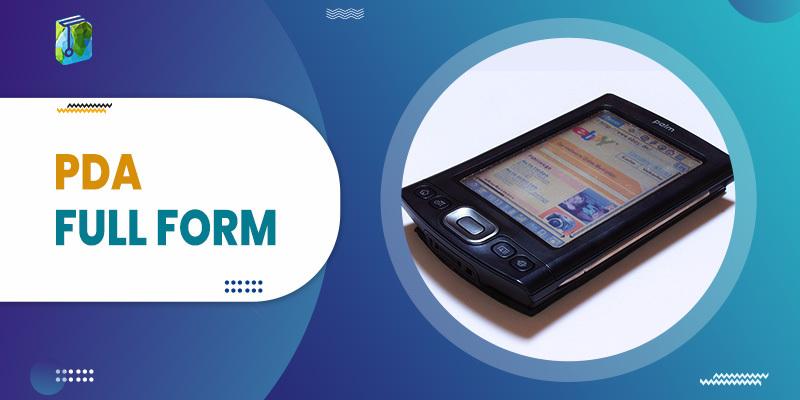The full form of PDA is referred to as Personal Digital Assistant.
Introduction
PDA is an electronic device that fits in the palm of the user’s hand to assist him or her in planning and organizing day-to-day activities by helping with such information as contacts, appointments, files, and programs. PDA can also write notes, read charts, link, upload, and access the Internet. PDA is also known as a palmtop or pocket computer.
- The term “PDA” includes “smart” pagers, Internet appliances, palm-size computers, and wearable computers.
- The evolution of PDAs, also called handhelds or palmtops, has enabled them to connect to the Internet, run multimedia software and act as global positioning system (GPS) devices.
- John Sculley, then CEO and Chairman of Apple, first explained the term “PDA”.
- The first PDA was the Newton MessagePad, developed by Apple. It was introduced in 1992 and made available to the general public in 1993.
- Among the many types of PDAs that are available now are Palm OS units, Windows CE, Symbian OS, PDAs, Tablet PCs, Blackberry devices, “smart” watches, “smart” pagers, and cellular phones with PDA functions. Amongst all, the most popular PDAs are the Palm and the Pocket PC.
Features of PDA
- Data Input: The method used for PDA data input is a pen stylus using a form of handwriting, touch-sensitive screens, and portable keyboards.
- Synchronization: Synchronization of data between a PDA and a desktop computer has been made possible through infrared and modem options.
- Display: The display screen of PDA may consist of a Thin Film Transistor (TFT) reflective color display, or grayscale touch-sensitive display, or a Graffiti input region in the screen.
- Run Application Software: PDAs can operate software applications like Word, Excel, Internet Explorer and Outlook along with Windows Media Player, voice memo recording, games, diet and exercise, travel, medical, time and billing, etc
- Processors and Memory: The original Windows CE devices had 2-4 MB RAM and usually had processors with 36-44 MHz clock speeds. The newest device comes with 32-64 MB RAM including the new 400 MHz CPU.17
- Expansion Methods: Several memory cards specified by industry standards like The CompactFlash (CF), SmartMedia card, the multimedia card can be used to expand the memory of PDA.
- Datebook: Input meetings and appointment information can be completed with notes, location information, and even set a reminder to perform tasks on time.
- Memo Pad: PDA allows the user to jot down notes; write a book, keep lists, and more using its note-taking capabilities.
- Calculator: Perform simple or complex computations.
- To-Do List: Help keep track of daily events and accomplish things that need to get done.
- Address Book: Keep track of important contacts.
- Onscreen Keyboard: Input information is allowed using the touch screen and a stylus. Graffiti (Palm) / Character Recognizer (Pocket PC / Windows Mobile) — Allows input information using your handwriting instead of an on-screen keyboard.
- Email: Email can be composed and sent using a wireless connection or can be stored by synchronizing PDA with a computer.
PDA Functions
Though each PDA performs distinct functions, some of the most common functions of a PDA are:
- The tedious job of planning on paper and then managing those papers can be omitted with the use of a small device called PDA. Also, the quantity of information they can store is much higher than that of a bunch of paper.
- PDAs with short-range wireless connectivity using Infrared (IR) or Bluetooth technology are used to sync with a notebook computer that has an IR port, thus making the exchange of data possible.
- Internet and corporate network connectivity through Wi-Fi and wireless access points enable a PDA user to connect with the surrounding.
- PDA maintains the privacy of data through integrated security features such as a biometric fingerprint reader.
Conclusion
Hope now you have learned about the full form of PDA, the features of a PDA, and how a PDA functions. Still, if you have any doubts or queries related to PDA, do mention it in the comments section below. We would try to answer it at the earliest.

